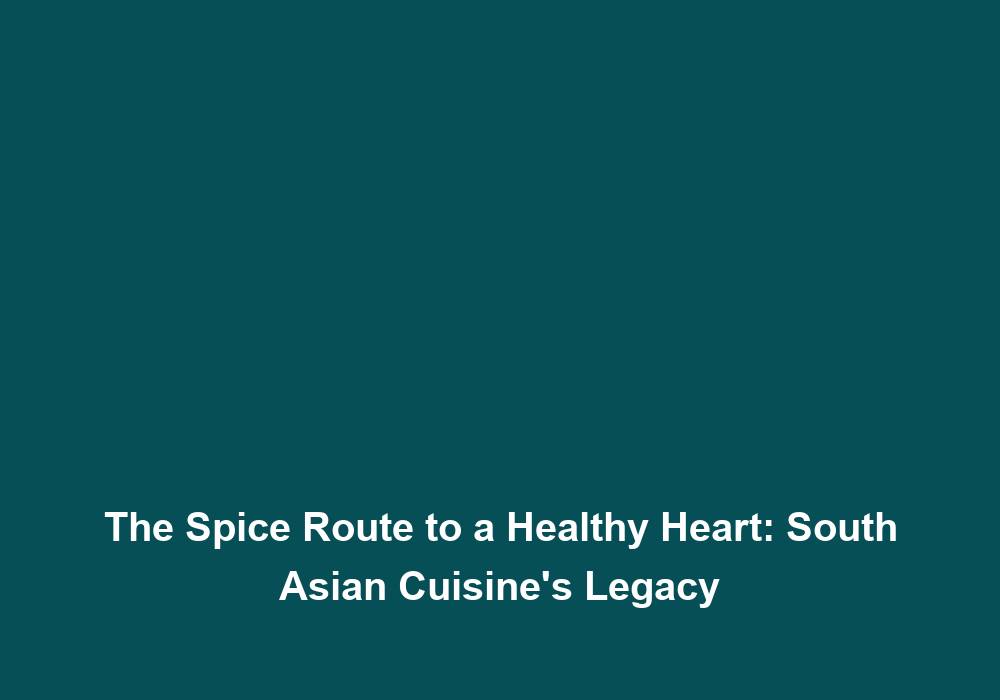The Spice Route to a Healthy Heart: South Asian Cuisine’s Legacy
South Asian cuisine is renowned worldwide for its vibrant flavors, rich spices, and aromatic herbs. Beyond tantalizing taste buds, these flavorful ingredients offer numerous health benefits, particularly when it comes to heart health. The intricate blend of spices and herbs used in South Asian cooking not only adds depth and complexity to dishes but also serves as a natural pharmacy for maintaining a healthy heart.
The Power of Spices and Herbs
Spices and herbs are the heart and soul of South Asian cuisine. They not only enhance the taste and aroma of food but also provide a multitude of health benefits. Let’s explore some of the key spices and herbs that have been traditionally used in South Asian cooking for promoting heart health:
1. Turmeric
Turmeric is a bright yellow spice that contains a powerful compound called curcumin. Curcumin is known for its strong anti-inflammatory properties and has been associated with a reduced risk of heart disease. It helps lower cholesterol levels, prevents the formation of blood clots, and improves the function of blood vessels, thus promoting cardiovascular health.
Turmeric can be incorporated into your diet in various ways. You can use it as a spice in curries, stir-fries, or soups. It can also be added to smoothies or warm milk for a soothing beverage. Additionally, turmeric supplements are available for those who prefer a more concentrated dose of curcumin.
2. Cinnamon
Cinnamon is a sweet and fragrant spice that has been linked to heart health. It helps reduce blood pressure and cholesterol levels, improves blood circulation, and has anti-inflammatory properties. Incorporating cinnamon into your diet can be as simple as adding a sprinkle to your morning oatmeal or using it to flavor your tea.
To reap the maximum benefits of cinnamon, opt for Ceylon cinnamon, also known as “true” cinnamon, as it contains higher levels of beneficial compounds compared to other varieties. You can also try adding cinnamon to baked goods, smoothies, or roasted vegetables for a delicious twist.
3. Garlic
Garlic is a staple ingredient in South Asian cooking and has been used for centuries for its medicinal properties. It contains compounds that help lower blood pressure, reduce cholesterol levels, and prevent the formation of blood clots. Consuming garlic regularly can significantly contribute to maintaining a healthy heart.
To incorporate garlic into your meals, consider using fresh garlic cloves in your curries, stir-fries, or marinades. You can also roast whole garlic bulbs for a milder flavor or use garlic powder as a convenient alternative. However, it’s important to note that excessive consumption of garlic may interact with certain medications, so it’s always advisable to consult with a healthcare professional if you have any concerns.
4. Ginger
Ginger is a versatile spice that adds a unique flavor and warmth to dishes. It has been used in traditional medicine for its anti-inflammatory and antioxidant properties. Ginger helps lower blood pressure, reduce cholesterol levels, and improve blood circulation, thereby benefiting heart health.
Incorporating ginger into your diet can be as simple as adding freshly grated ginger to your curries, soups, or teas. You can also use ginger powder in baking or sprinkle it on roasted vegetables for an extra kick. For a refreshing twist, try infusing water with ginger slices and other fruits or herbs.
5. Cardamom
Cardamom is a highly aromatic spice commonly used in South Asian desserts and beverages. It has been found to have antioxidant and anti-inflammatory properties, which contribute to improved heart health. Cardamom helps lower blood pressure and cholesterol levels, making it a valuable addition to a heart-healthy diet.
To incorporate cardamom into your meals, you can add it to your morning coffee, tea, or smoothies for a fragrant and flavorful boost. It can also be used in baking, rice dishes, or yogurt-based desserts for a unique twist.
Traditional South Asian Ingredients for Heart Health
In addition to the spices and herbs mentioned above, several other ingredients commonly found in South Asian cuisine can contribute to a healthy heart. Let’s explore some of these key ingredients:
1. Whole Grains
Whole grains such as brown rice, whole wheat, and millet are staples in South Asian cuisine. They are rich in fiber, vitamins, and minerals, which help lower cholesterol levels, regulate blood sugar, and reduce the risk of heart disease. Including whole grains in your diet can provide essential nutrients for a healthy heart.
To incorporate whole grains into your meals, you can replace refined grains with whole grain alternatives like brown rice or whole wheat bread. Experiment with different grains like quinoa or barley to add variety to your diet. Including whole grain rotis (flatbreads) or chapatis as a staple in your meals is also a great way to increase whole grain intake.
2. Legumes
Legumes like lentils, chickpeas, and kidney beans are a significant part of South Asian cuisine. They are an excellent source of plant-based protein, fiber, and antioxidants. Legumes help reduce cholesterol levels, stabilize blood sugar, and promote heart health. Incorporating legumes into your meals can be as simple as making a delicious lentil curry or adding chickpeas to a salad.
To enjoy the benefits of legumes, consider adding them to stews, soups, or salads. Lentils can be used as a base for vegetarian curries or made into flavorful dals (lentil soups). Chickpeas can be roasted for a crunchy snack or blended into hummus for a healthy dip. Exploring different legume varieties and recipes will add diversity to your diet while benefiting your heart.
3. Fresh Fruits and Vegetables
South Asian cuisine is abundant in a variety of fresh fruits and vegetables. These colorful and nutrient-rich foods provide essential vitamins, minerals, and antioxidants that support heart health. Including a variety of fruits and vegetables in your diet will ensure you receive a wide range of beneficial nutrients.
To increase fruit and vegetable intake, aim to include a colorful assortment in your meals. Fresh fruits can be enjoyed as snacks, added to salads, or used in smoothies and desserts. Vegetables can be stir-fried, roasted, or used as ingredients in curries and soups. Experimenting with different cooking techniques and exploring local and seasonal produce will add freshness and vibrancy to your heart-healthy meals.
4. Healthy Fats
Healthy fats like those found in nuts, seeds, and oils like olive oil are integral to South Asian cuisine. These fats are rich in omega-3 fatty acids, which help reduce inflammation, improve cholesterol levels, and promote heart health. Incorporating these healthy fats into your cooking can be as simple as adding a handful of almonds to your evening snack or drizzling olive oil over your salad.
To incorporate healthy fats, consider using olive oil or other plant-based oils for cooking and salad dressings. Snack on a handful of nuts or seeds for a satisfying and heart-healthy treat. You can also use nut butters as a spread or add them to smoothies for a creamy texture. Moderation is key when consuming healthy fats, as they are high in calories, so portion control is important.
Making South Asian Cuisine Heart-Healthy
While South Asian cuisine offers a fantastic array of heart-healthy ingredients, it’s essential to prepare dishes in a way that maximizes their benefits. Here are some tips to make your South Asian meals heart-healthy:
- Opt for lean protein sources like skinless chicken, fish, or tofu instead of red meat. These alternatives are lower in saturated fat and cholesterol, making them better choices for heart health.
- Use healthier cooking methods like grilling, baking, or steaming instead of deep-frying. This reduces the amount of added fats and calories in your dishes.
- Minimize the use of excessive oil and ghee (clarified butter) in your cooking. While some oil is necessary for flavor and texture, using it sparingly can help reduce overall calorie and fat intake.
- Choose low-fat dairy products like yogurt instead of full-fat versions. This reduces the intake of saturated fats while still providing essential nutrients like calcium.
- Limit the intake of salt and use spices and herbs to enhance the flavor of your dishes. Excessive salt consumption can contribute to high blood pressure, so incorporating flavorful spices and herbs can add depth and taste without relying on salt.
- Focus on portion control and balance your meals with adequate servings of vegetables, whole grains, and lean proteins. This ensures a well-rounded and nutritious meal while avoiding excessive calorie intake.
By incorporating these tips into your cooking and making mindful choices, you can enjoy the flavorsome delights of South Asian cuisine while reaping the benefits of a heart-healthy diet.
Conclusion
South Asian cuisine’s legacy goes beyond its delicious flavors, offering a treasure trove of ingredients that promote heart health. The spices, herbs, and traditional ingredients used in South Asian cooking have been known for their numerous health benefits. From turmeric and cinnamon to garlic and ginger, these ingredients help lower blood pressure, reduce cholesterol levels, and improve overall cardiovascular health. By incorporating these heart-healthy ingredients into your diet and making mindful choices, you can embark on a flavorful journey to a healthy heart through the spice route of South Asian cuisine.







